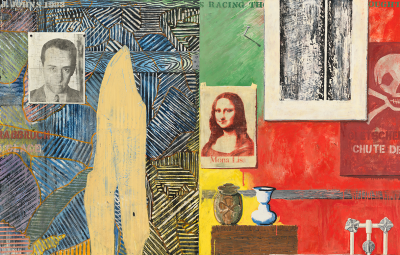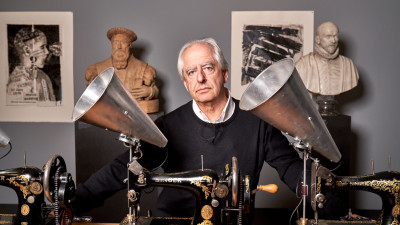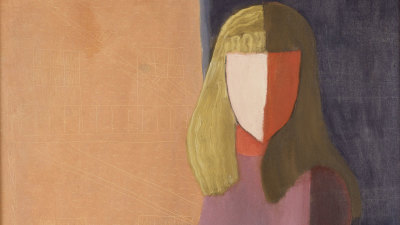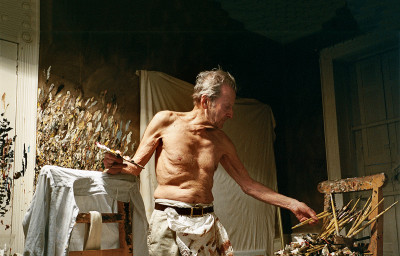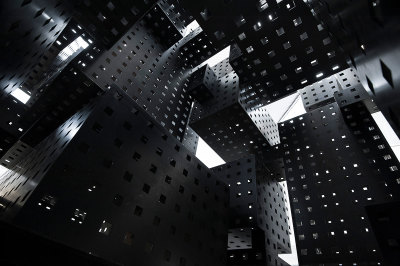Jasper Johns: a beginner’s guide
Jasper Johns: a beginner’s guide
By Tom Jeffreys and Anna Testar
Published 21 August 2017
In autumn 2017 we celebrate the work of pioneering American artist Jasper Johns. The exhibition spans over six decades of ground-breaking work, exploring this highly innovative artist through an extraordinary selection of paintings, sculptures, drawings and prints.
-
Taking place in our expansive Main Galleries, Jasper Johns: ‘Something Resembling Truth’ is the next in the RA’s series of shows dedicated to the world’s most significant living artists, following on from Anselm Kiefer and Ai Weiwei. From his early representations of ubiquitous symbols such as flags and numbers, to reinterpretations of everyday objects, to more recent reflections on memory, history and biography, this is the most comprehensive survey of Johns’s work in the UK for 40 years.
For those unfamiliar with it, here are six facts to help you delve into a fascinating career.
-
-
Jasper Johns forged a new path for contemporary art
Jasper Johns emerged onto the American art scene in the 1950s. His densely textured paintings of recognisable objects like flags, targets, maps and numbers marked a significant shift away from Abstract Expressionism, which was then the major artistic movement in New York.
In 1958, at the age of 28, Johns was given his first solo show at the Leo Castelli Gallery. The exhibition was visited by Alfred H. Barr, the first director of the Museum of Modern Art, who purchased three pieces for the museum, cementing the young artist’s status as a central figure in the New York art world.

-
-
He has made some of the most recognisable artworks in the world
The flag paintings that Johns began producing in the 1950s are among his most famous works. The first of these, Flag (1954–55), was prompted by a dream: “One night I dreamed that I painted a large American flag” he recalled, “and the next morning I got up and I went out and bought the materials to begin it”. He started out working in household paint but was unhappy with the results, so he switched to an ancient technique known as encaustic, which involves dissolving paint into melted beeswax. The mixture dries very quickly and so preserves the precise details of the brushstrokes, resulting in the beguiling, tactile surfaces that characterise much of Johns’s work.
In addition to the flags, Johns’s interest in reformulating recognisable signs and symbols as artworks has seen him use targets, maps, numbers and alphabets to encourage the viewer to take a more active role in perception and to look afresh at “things which are seen and not looked at, not examined”. Forever questioning meaning, Johns has pushed the form of his subjects to the absolute limits, with numbers repeated until they no longer make sense and letters that are almost impossible to read.
He continues to inspire curiosity
Critics have long disagreed over the reasons behind Johns’s decision to paint the American flag. Some argue that he simply wanted to use a familiar, everyday image in order to focus on the technique of painting. Others have linked the flag paintings to the ongoing Cold War and the fears stoked up by McCarthyism. Critic Robert Hughes said that the Cold War “brought national paranoia to both Russia and America and in its grip of fear and self-assertion all symbols of American identity got a new charge – including, most obviously, the flag”. Johns himself has maintained that he was simply inspired by a dream.
-

Jasper Johns, Painting Bitten by a Man, 1961.

Jasper Johns, Watchman, 1964.

Jasper Johns, Painting with Two Balls, 1960.
-
-
Johns is more than a painter
After establishing himself as a painter in the 1950s, Johns began making lithographs in 1960. Printmaking soon proved to be an ideal tool for an artist concerned with repetition and re-examination, providing Johns with a means to manipulate the motifs that informed his paintings over and over again. The resulting output of lithographs, etchings, screenprints, aquatints and intaglios has placed Johns alongside Pablo Picasso and Edvard Munch as one of the most important and innovative printmakers of the 20th century. He has also used sculpture to question “things the mind already knows”, as he has put it, casting torches, lightbulbs, ale cans and objects from his studio in bronze, wittily reformulating everyday objects as precious works of art.
He has collaborated with some of the greatest artists, writers and composers of his generation
Soon after settling in New York in 1953, Johns formed a close circle of friends that included the choreographer Merce Cunningham, the composer John Cage, and the artist Robert Rauschenberg. The group met regularly to share ideas, and in 1963 they formed the Foundation for Contemporary Performance Arts. Of his relationship with Johns, Rauschenberg recalled that “Jasper and I literally traded ideas. He would say, ‘I’ve got a terrific idea for you,’ and then I’d have to find one for him”.
In 1968 Johns designed the set for Merce Cunningham’s Walkaround Time using Marcel Duchamp’s The Bride Stripped Bare by her Bachelors, Even (The Large Glass) (1915–23) for inspiration. The same year, he designed the costumes for another piece by Cunningham, Rainforest, while Andy Warhol designed the set. In 1976, Johns produced 33 etchings for a set of five texts by the Irish writer and poet Samuel Beckett in a publication they titled Foirades/Fizzles.

-
-

Jasper Johns, Between the Clock and the Bed, 1981.

Jasper Johns, Racing Thoughts, 1983.

Jasper Johns, Regrets, 2013.
-
He holds a singular position in the history of art
Johns has a deep knowledge of art history, which has always played a central role in his work. His early paintings and sculptures paid homage to the ready-mades of Marcel Duchamp, while the cross-hatching motif he developed in the 1970s found its origins in Edvard Munch’s Self Portrait. Between the Clock and the Bed (1940–43). Harlequin patterns in the Bushbaby series of 2003 to 2006 can be traced to Pablo Picasso’s paintings of harlequins made at the beginning of the 20th century, and his 2012 series Regrets took as its starting point a photograph of Lucian Freud by the photographer John Deakin.
In turn, Johns has been hugely influential on younger generations of artists. His focus on the work of art as an object in its own right paved the way for Minimalism, while his appropriation of familiar everyday imagery was a major influence on Pop Art. In 2011, Johns became the first artist since 1978 to be awarded the Presidential Medal of Freedom. He is widely regarded as one of the most important artists of the 20th century and is still making work today.
-

President Barack Obama presents a 2010 Presidential Medal of Freedom to American artist Jasper Johns, during a ceremony in the East Room of the White House in Washington.
Photo by Brooks Kraft LLC/Corbis via Getty Images
-
Jasper Johns: ‘Something Resembling Truth’ is in the Main Galleries at the Royal Academy until 10 December 2017.
Tom Jeffreys (@tomjeffreys) is a writer, editor and curator. Anna Testar is an assistant curator in the RA Exhibitions department.






